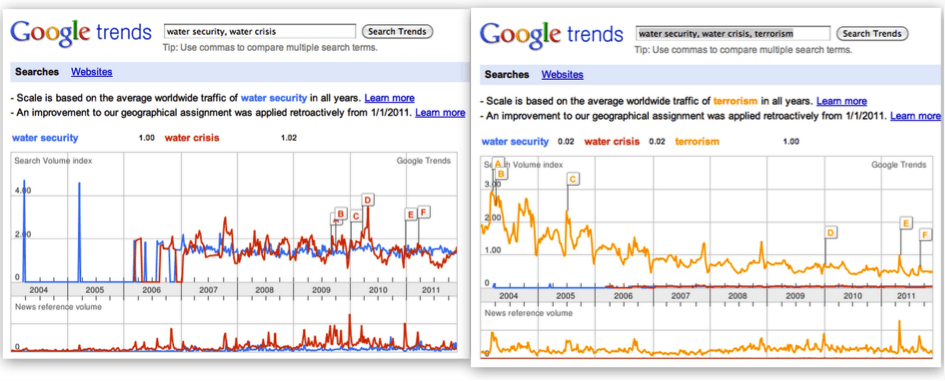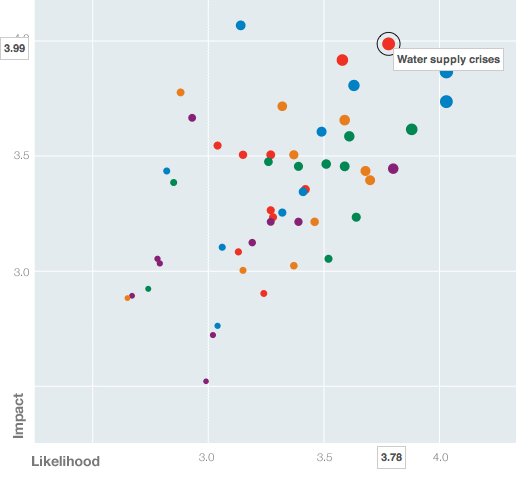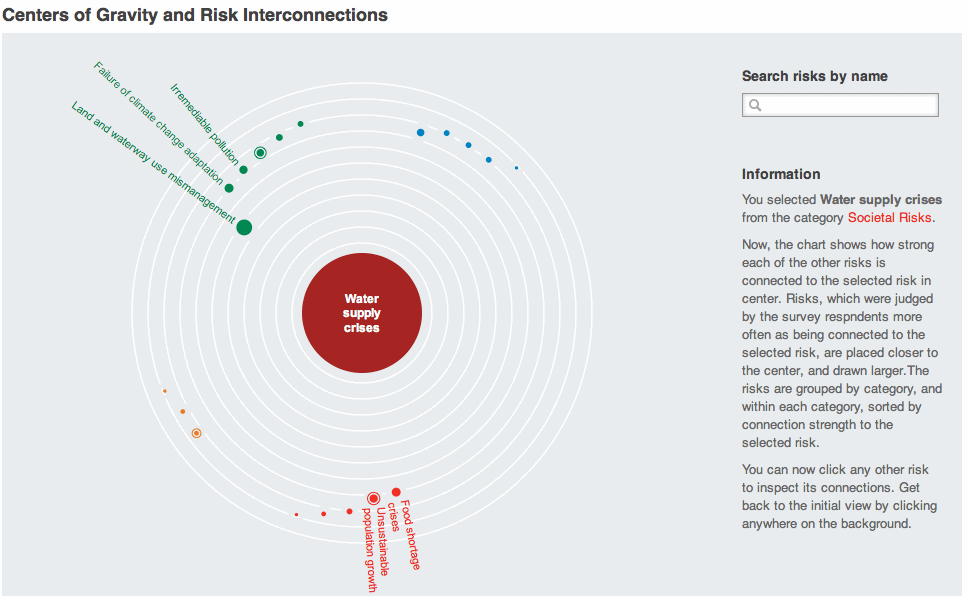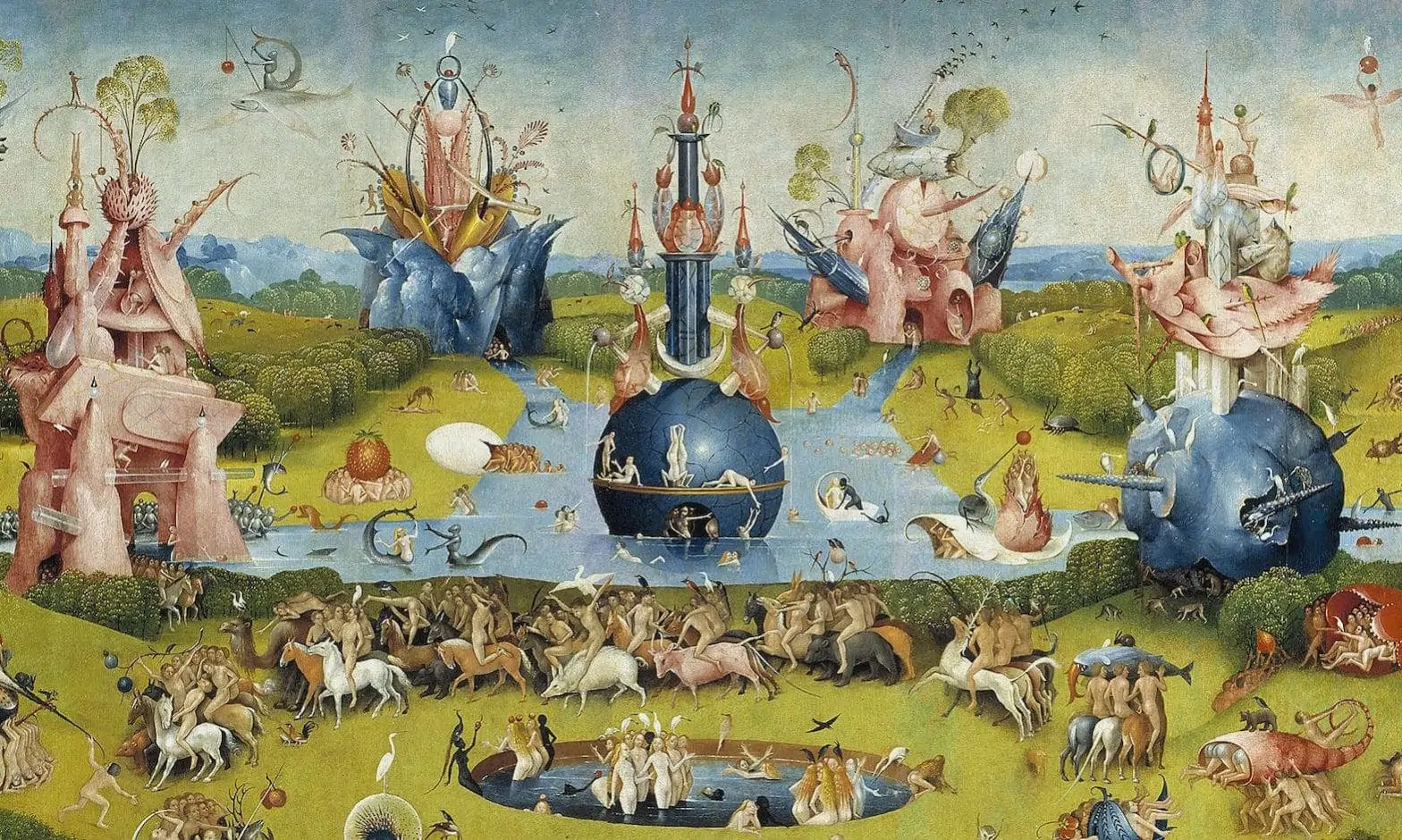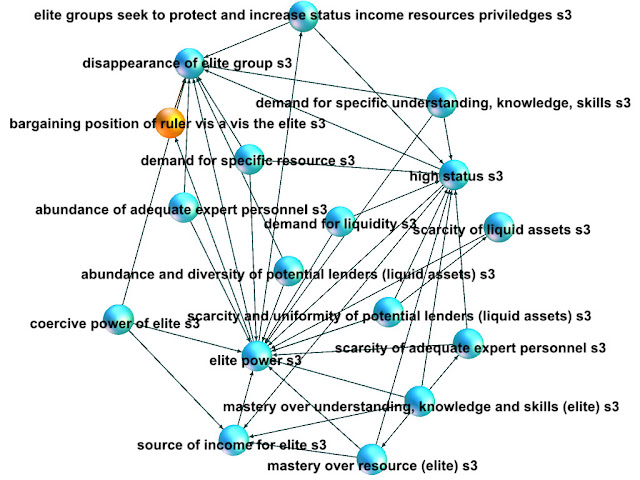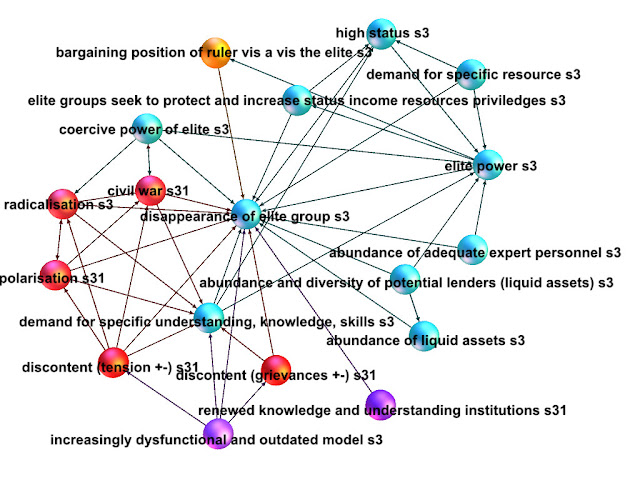Last week’s summary: In 2212 EVT, Everstate (the ideal-type corresponding to our very real countries created to foresee the future of the modern nation-state) knows a rising dissatisfaction of its population. The increasing incapacity of the political authorities to deliver the security citizens seek increases the risks to the legitimacy of the whole system. The first two phenomena driving Everstatan political authorities’ incapacity to deliver security are a deepening budget deficit and an increasing need for liquidity, and a related creeping appropriation of resources while the strength of central public power weakens to the profit of various elite groups. The first of this group is the lenders’ nexus. The second type of elite groups is developing strongholds focused on those resources needed by Everstate and is exemplified by an extreme form …
2212 EVT: the Power of Novstate (The Chronicles of Everstate)
Last week’s summary: In 2012 EVT, the deepening chronic budget deficit and the rising need for liquidity of Everstate (the ideal-type corresponding to our very real countries created to foresee the future of the modern nation-state) give an increasing power to the lenders elite group, allowing for new forms of appropriation of public power. Everstate sinks into a vicious circle. (The reader can click on each picture to see a larger version in a new tab). On the difficulty of cooperating with elite groups The second phenomenon driving Everstatan political authorities’ incapacity to deliver security is a related creeping new appropriation of public resources and a weakening of the strength of central public power to the profit of various elite groups, the first of which was the lenders’ nexus. As many …
Continue reading “2212 EVT: the Power of Novstate (The Chronicles of Everstate)”
2212 EVT: Public Resources and Lenders (The Chronicles of Everstate)
Last week’s summary: In 2012 EVT, Everstate (the ideal-type corresponding to our very real countries created to foresee the future of the modern nation-state) sees a mounting discontent of its population because it has become insecure considering the impact of the new still misunderstood conditions. Three related phenomena drive Everstatan political authorities’ incapacity to deliver security. First, Everstate faces a changing set of resources implying an income that is relatively too low while costs and expenditures resulting from accumulated threats and pressures rise inexorably. Added to an Inability to understand the situation and a use of past recipe, this leads to both a chronic and deepening budget deficit and an increasing demand for liquidity. Individually, citizens face the same challenge, which heightens the need for liquidity. (The reader can click …
Continue reading “2212 EVT: Public Resources and Lenders (The Chronicles of Everstate)”
Global Water Security
A Strategic Foresight and Warning Issue for National Security
In the light of the 31 january 2012 “Unclassified Statement for the Record on the Worldwide Threat Assessment of the US Intelligence Community for the Senate Select Committee on Intelligence” by James R. Clapper Director of National Intelligence, which identifies Water Security in the chapter on Significant State and Nonstate Intelligence Threats (p.29), this is an updated version of a post initially published on The Water Chronicles, December 8, 2011.
The emergence of a global water crisis seems to be a fact that is reaffirmed across actors almost everyday, even if the overall web worldwide traffic devoted to the topic is still marginal compared to terrorism for example, as shown by the two graphs below.
Witness to this double characteristic of importance and relative lack of awareness, the National Geographic, for example, in 2005, had a whole section devoted to the water crisis or more precisely freshwater crisis to contribute to raise interest: the National Geographic’s Freshwater Initiative. It remains (2021) as The Freshwater crisis.
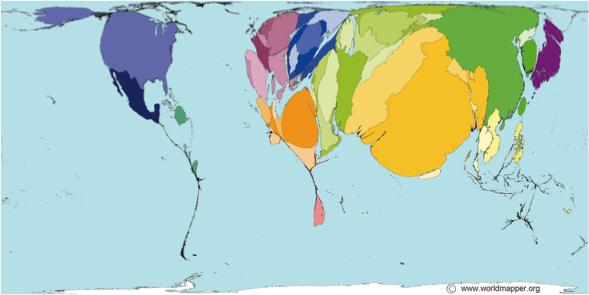
This global water crisis would spare no country, from the most powerful, as underlined again in the December 4, 2011 Tomgram: William deBuys, The Parching of the West for the U.S. to richer ones such as Singapore, for example, which faces a “lack of natural water resources.” Meanwhile Mapelcroft identifies in 2011 Bahrain, Qatar, Kuwait and Saudi Arabia as “the most water-stressed countries in the world,” – each ranking respectively in terms of wealth, 3rd, 34th, 1st, 14th, 41st, IMF 2010. Emerging countries are not spared: for example, India faces many water problems from pollution to water depletion, while poorest countries sometimes face further desertification. This wide and unremitting geographic scope also further questions the fading developed-rich/developing-poor countries cognitive model inherited from both the self determination period and the three-worlds Cold War world view, asking from us to revisit our perceptions if we are to understand contemporary challenges and crises and ever hope to solve or more modestly mitigate them.
Meanwhile, various related research programs in universities and think tanks throughout the world have been developed. As indication, Academia.edu references 100 programs, 53 universities and 39 academic journals focused on water. Among others, since 1991 a World Water Week has been organised, initially by the Stockholm Vatten AB, the municipal water and wastewater provider, on behalf of the City of Stockholm (SIWI, history). It led to the creation of the Stockholm International Water Institute in 1997. According to its organisers the World Water Week has become “the annual focal point for the globe’s water issues.”
Furthermore, water related risks have been identified by the Global Risks Reports of the World Economic Forum (WEF – Davos) under one label or another since 2007. The 2012 Global Risks Report underlines the severity of the water threat, which belongs now to the top 5 risks: water supply crises rank 5th in terms of likelihood, and 2d in terms of impact. An encompassing “water security” had been already singled out in the 2011 Global Risk Report as “the top 10th risk by likelihood and impact combined.” The risk was deemed to be not only very likely but also to have a perceived impact approaching 500 billion USD. Compared with the 2010 perceived impact (then for water scarcity – risk 22 – and not water security) the perceived impact skyrocketed from an estimate of less than 40 billion USD.
Furthermore, in 2011, the water security risk is seen as interconnected with eight other risks and in 2012 water supply crises are linked to nineteen risks, as shown on the figures realised thanks to the very interesting interactive way the reports are presented online. The water-food-energy risk nexus is amply detailed in the 2011 report and benefits of a specific initiative: http://www.weforum.org/water. Water is on the Agenda of the Global Councils of the WEF since 2008.
Meanwhile, and as expected from the interconnections shown by the Global Risks Report 2011, water is widely seen as a cause of strife and conflict, as recalled by a recent New York Times blog by Rachel Nuwer, “The power politics of water struggles,” focusing notably on the idea of hydro-hegemony, a framework for analysis of trans-boundary water conflicts, conceptualized by the Canadian Dr Mark Zeitoun of the University of East Anglia. As explained in an article by Zeitoun and Warner, “Hydro-hegemony is hegemony at the river basin level, achieved through water resource control strategies such as resource capture, integration and containment. The strategies are executed through an array of tactics (e.g. coercion-pressure, treaties, knowledge construction, etc.) that are enabled by the exploitation of existing power asymmetries within a weak international institutional context” (2006).
Indeed, the Water and Sustainability Program of the Pacific Institute, in its World Water Conflict Chronology Map presents an exhaustive chronology of 225 water conflicts displayed on an interactive map, showing both their global historical and geographical scope. Conflicts identified in the project start with the c. 3000 BC deluge also told by Sumerian myth, which underlines another potentially crucial dimension of the water issue, its relation to myth, symbolism and the sacred, within a larger cultural dimension as specified on other grounds by Roberto Melville and Claudia Cirelli (2000). The last updated conflict relates to 2010 violent water protests in India thus showing the influence of water on domestic issues, while more conventional disputes with potential for escalation and war are not forgotten, with the example the India-Pakistan Indus dispute (1947-1960s).
We thus have present as elements of this global water crisis: wars and perception of foreign enemies, break down of order and protests, threat to food security, and more generally life, as well as symbolic and customary meaning. Those are nothing else than potential and emergent symptoms that could lead to failure to ensure security, which is the mission of the ruler. Indeed, Moore (1978, 22) “defines the mission of security of authorities as comprising three elements: protection from foreign enemies, foreign being defined by what does not belong to the sphere of the ‘we,’ maintenance of peace and order, and contribution to ‘material security,’ or ‘security against supernatural, natural and human threats to the food supply and other material supports of customary daily life’” (Lavoix, 2010). As we still live, for the great majority, in nation-states, this security is nothing else than national security (conventional security tends to refer to strictly military matters, while unconventional security is being used for any other relevant issue).
To avoid such security failures that would not only have direct dire consequences but also impact in terms of legitimacy, rulers (andmore boradly all actors that could be impacted or are players) have at their disposal a process and analytical tool that helps them anticipating uncertain changes and thus preventing them, mitigating them at best or taking advantage of them when theose changes are opportunities. This process is called Strategic foresight and warning (SF&W). It “is an organized and systematic process to reduce uncertainty regarding the future (Fingar, 2009). It aims to allow policy-makers and decision-makers to take decisions with sufficient lead-time to see those decisions implemented at best (Davis; Grabo 2004; Knight, 2009). It must thus helps us in identifying the frontiers of plausibility within which changes in our surroundings are most likely to take place within a specific period of time, so that we can best coordinate our activities for our society’s security, in the light of those coming alterations” (Lavoix, 2011).
———-
References
Davis, Jack, “Strategic Warning: If Surprise is Inevitable, What Role for Analysis?” Sherman Kent Center for Intelligence Analysis, Occasional Papers, Vol.2, Number 1, accessed June 28, 2010.
DeBuys, William, Tomgram: William deBuys, The Parching of the West, Tomdispatch.com, December 4, 2011.
Fingar, Thomas, “Anticipating Opportunities: Using Intelligence to Shape the Future,” and ”Myths, Fears, and Expectations,” Payne Distinguished Lecture Series 2009 Reducing Uncertainty: Intelligence and National Security, Lecture 3 & 1, FSI Stanford, CISAC Lecture Series, October 21, 2009 & March 11, 2009, accessed June 28, 2010.
Government of Singapore, PUB Singapore’s National Water Agency.
Grabo, Cynthia M., Anticipating Surprise: Analysis for Strategic Warning, edited by Jan Goldman, (Lanham MD: University Press of America, May 2004).
Knight, Kenneth, “Focused on foresight: An interview with the U.S.’s national intelligence officer for warning,” McKinsey Quarterly, September 2009, accessed June 28, 2010.
Lavoix, Helene, “Enabling Security for the 21st Century: Intelligence & Strategic Foresight and Warning,” RSIS Working Paper No. 207, August 2010.
Lavoix, Helene, Ed. Strategic Foresight and Warning: Navigating the Unknown. Singapore: RSIS-CENS, 2011.
Mapelcroft, “Maplecroft index identifies Bahrain, Qatar, Kuwait and Saudi Arabia as world’s most water stressed countries: Key emerging economies and oil rich nations export water issues to ensure food security through African ‘land grab’,” 25/05/2011.
Melville, Roberto and Cirelli, Claudia, “LA CRISIS DEL AGUA. Sus dimensiones ecológica, cultural y política.” (LA CRISE DE L’EAU. Ses dimensions écologiques, culturelles et politiques), Memoria # 134 en abril del año 2000; further translations.
Moore, Barrington, Injustice: The Social Bases of Obedience and Revolt, (London: Macmillan, 1978).
National Geographic, National Geographic’s Freshwater Initiative.
Nuwer, Rachel, “The power politics of water struggles” New York Times blog, 28/11/2011.
Pacific Institute, World Water Conflict Chronology Map
Stockholm International Water Institute, “History”
The World Economic Forum,
- World Economic Forum Global Risk Report 2006.
- World Economic Forum Global Risk Report 2007.
- World Economic Forum Global Risk Report 2008.
- World Economic Forum Global Risk Report 2009.
- World Economic Forum Global Risk Report 2010.
- World Economic Forum Global Risk Report 2011.
- World Economic Forum Global Risk Report 2012.
Wikipedia, “List of countries by GDP (PPP) per capita.”
World Mapper, “Water Depletion Map,” Water series, Map 323,
Zeitoun, Mark, and Warner, Jeroen, « Hydro-hegemony – a framework for analysis of trans-boundary water conflicts,» Water Policy Vol 8 No 5 pp 435–460 © IWA Publishing 2006 doi:10.2166/wp.2006.054.
Budget Deficit and Liquidity (The Chronicles of Everstate)
That year, in Everstate (the ideal-type corresponding to our very real countries created to foresee the future of the modern nation-state), people seek security as they increasingly feel the negative impact of various pressures and threats on their life. Henceforth they turn to their political authorities and even start trying to compel them to provide this security. Through those actions, Everstatans start to remember that, as part of the nation, they are also rulers of Everstate. Yet, the situation is growing worse because the tasks of governance have grown more complex while the governing system and the polity are not yet adapted to the new conditions.
The first phenomenon driving Everstatan political authorities’ incapacity to deliver security is a deepening budget deficit and an increasing need for liquidity[…]
2212 EVT: Seeking Security (The Chronicles of Everstate)
Summary of our scenario so far: In 2012 EVT, in Everstate, the ideal-type corresponding to our very real countries created to foresee the future of the modern nation-state, the population’s discontent increases. It is bound to continue to do so, as a result of various pressures and threats, most of them inevitable, imperfectly identified, and not understood. Indeed, Everstatans feel both directly and indirectly the impact of those pressures, which affect their sense of security and thus generate discontent (link to previous article).
As a result, now, Everstatans continue to seek a security that is appearing as increasingly distant and elusive…. read more
2212 EVT: Rising Discontent (The Chronicles of Everstate)
Summary of our scenario so far: Everstate (an ideal-type for our very real countries created to foresee the future of the modern nation-state) is part of the international liberal order and ruled under a democratic parliamentary regime.
Lately, its governance started being less efficient and as a result began to fail to ensure the security of Everstate’s citizens. Meanwhile, its economy showed sign of losing efficacy and its powerful elite groups fought hard to keep their status although they do not believe to be really at risk.
The various degradations and tensions have started being felt and registered by the population. However, most Everstatan actors considered those as temporary crises and difficulties that will be shortly solved. At worst, some envisioned a serious crisis that would last a few years, maybe a decade of slow growth before everything went back to normal (link to previous article). Are they right? What does the future hold for Everstate?… Read more
Everstate: Setting the stage (2)
Summary of our scenario so far: Everstate is an ideal-type for our very real countries created to foresee the future of the modern nation-state. In the case of this specific scenario-building, we are setting the stage for Everstate, by attributing values to key influencing variable to be able to develop the scenarios.
As previously set, Everstate is thus a middle-range power located on the Eurasian land mass and part of the international liberal order. It is ruled under a democratic parliamentary regime. It obeys an array of norms and their institutional administrative offshoots at international, regional and national level. Its governance is thus complex. Lately, that governance started being less efficient and as a result began to fail to ensure the security of Everstate’s citizens.
An increasingly inefficient economy
Meanwhile, the economy was starting to be less efficient. True enough, Everstate, with its still fair governance, inheriting a past positive economic situation was still receiving its share of foreign direct investments (FDI), while also investing in other countries, thus being fully part of the enmeshed globalised world.
Yet, the growth, upheld by the normative order as main objective, panacea and ideal, tended to increasingly stall and chronic unemployment had slowly started to settle in. Meanwhile, poverty had not been eradicated and was again on the rise, while inequality decupled. However, the normative model still justified the resource repartition and, for example, those who were poor tended to be seen as lazy, worthless and as social misfits, who did not want to enter the system and work.
Most analysts and analyses were focusing on old ways to understand economics, which had been so useful in the past, revisiting debates and quarrels over Keynes, Hayek, Marx, and others for example. Yet, most failed to find explanations and solutions to the current degrading efficiency and slowing growth. Meanwhile, obvious factors were most often overlooked.
The evolution of society towards more complexity affected not only governance but also economy and its efficiency. Its impact on the initial resources available was also playing a part: for example, science, production models, socio-political models, changes in ways of life, and demography had profoundly altered not only agriculture but also available resources such as land, water, seeds, and food resources. Furthermore, the evolution of society coupled with the evolution of resources had strongly impacted the ecological milieu, for example through biodiversity impacts and climate change, which in turn affected directly the efficiency of the economy. New resources could emerge that had been unheard of previously, e.g. biofuels, or massive influx of jellyfish that altered the whole life of Everstate’s seashore. More generally, resources also displayed a trend towards an increasing complexity, with consequences on the economy. Similar dynamics were at work in any sector, including the emergence of the very new (in terms of human history) virtual world.
Changes in the economy’s efficiency had effects on the security provided to citizens, would it be only directly through a more uncertain material security. Indirect effects, in as much as governance seemed unable to favour a return to the security ante, were also to be expected, with time. However, those consequences were still deemed as temporary and relatively minor in terms of scope (the number of people being affected) and intensity. Citizens had started expressing the fact they felt those effects, but only through relatively mild discontent (mostly without any violence).
Another impact, initially mainly unnoticed, was that the demand for liquidity had started to grow. Indeed, the still existing economic growth needed liquidity, as well as the usual functioning of the economy. More importantly, the gap between lowered efficiency and stable or increasing needs had to be bridged by something and it was by liquidity.
The powerful Everstatan elite* under threat?
As for all elite groups, Everstatan elite power stemmed initially from their search to protect and increase their status and privileges, their resources and income. Then, obtaining and maintaining this power promoted the search for even more power, in a relentless dynamic.
Becoming part of elite groups is obtained throughout time and space by holding mastery or power over something that is needed by one’s polity. Three major areas can be identified that generate and then maintain elite power: understanding, knowledge and skills, specific (material) resources (e.g. land for a long period of human history), and, last but not least, liquid assets or liquidity.
The dynamics, in essence, run as follows: a polity needs specific resources (e.g. energy), understanding and skills (e.g. how best to see the economy function, or how best to manage the state apparatus according to the ongoing socio-political model), and liquid assets, with variation in terms of content, quantity and timing. When the need appears or increases, then those who possess the corresponding resource find themselves in the position to become crucial to their polity. The less numerous those who master this resource, the higher the power and related status they will get in return.
Status itself can also be considered as a symbolic resource of a specific kind that is hard to obtain but, once reached, favours mastery over the rest. Similarly, elite groups derive income from their various masteries that help them, if wisely used, to maintain their mastery then power. Finally, elite groups also develop coercive powers – when coercion is not the primary resource over which they have mastery – that help them achieving and maintaining their power.
The stronger the elite power, the stronger the elite bargaining position when negotiating with the ruler of the polity for those resources they master, which, in turn, leads to a rampant and hidden appropriation of the public domain, as is the case for Everstate. Furthermore, Everstate being a modern nation-state, organised according to a democratic regime, the tension occurs directly between elite groups and the nation, the real ruler of Everstate.
In Everstate, the rising demand for liquidity, notably, had enhanced the elite power of lenders and of the various financial actors, while the rising economic inefficiency had similar effects on economic actors including pundits.
Most notably, in Everstate as in most other countries, new elite groups had started rising, for example those linked to the virtual world.
Any new demand that would emerge would lead to the rise of a new elite group.
However strong the position obtained by entrenched elite groups, they may also disappear. Indeed, what creates them may lead to their demise, as resources become plentiful or disused, as skills and knowledge once scarce become widespread or as understanding suddenly fails.
Yet, elite group will not willingly accept their own disappearance, and will use any means to keep their power and status. At best they will promote changes in a bid to uphold their mastery over crucial resources. At worst they will block changes and fully involve their remaining means of power (income, coercion, status) in contests spurred by the discontent of the nation, playing an active role in polarisation and radicalization of society, favouring escalation towards conflict and finally most often ready to engage in wars.
The situation had definitely not reached this level of tension in Everstate as our story begins. Yet, the changes at work could let expect that some elite groups’ power was challenged, and could eventually lead to their demise, but no full awareness of this phenomenon had yet taken place. Notably, pro-active elite involved in economic efficiency, governance-related administrative and political elite, and knowledge and understanding institutions meant to provide explanation and models and related elite groups were most probably at risk.
The various mild degradations and tensions had been felt and registered by the population, sometimes involving protests under various forms, from abstention during elections to strikes and demonstrations, by the various elite groups, the government and the state. However, most Everstatan actors were most often considering them as temporary crises and difficulties that would be shortly solved, while everything would go back to normal. At worst, some envisioned a serious crisis that would last a few years, maybe a decade before everything went back to normal.
Are they right? What does the future hold for Everstate? Whatever happens on the shorter term, will it have impacts on the medium then longer term, and which ones? How will Everstate fare if or when confronted to tragic events, considering decisions taken during the first years?
Notes and References
* Along many scholars having worked on this topic, and on sub-issues, and who have informed the building of the overall map, I am more particularly greatly indebted to Thomas Ertman for his enlightening and masterful understanding of state-building. All mistakes and misunderstandings remain my own. Thomas Ertman, Birth of the Leviathan: Building States and Regimes in Medieval and Early Modern Europe, (Cambridge, Cambridge University Press, 1997). For a review of Ertman’s book, see, for example: Ariel Zellman’s Review: Birth of the Leviathan by Thomas Ertman.
Anderson, Benedict, Imagined communities: reflections on the origin and spread of nationalism, (New York: Verso 1991).
Ertman, Thomas, Birth of the Leviathan: Building States and Regimes in Medieval and Early Modern Europe, (Cambridge, Cambridge University Press, 1997).
Robert Taylor, The State in Burma, (London: Christopher Hurst, 1987) – notably for the separation between public and private domain, see p.66.
Zellman, Ariel, “Birth of the Leviathan by Thomas Ertman” Blog post
Constructing a Foresight Scenario’s Narrative with Ego Networks
In many foresight methods, once you have identified the main factors or variables and reach the moment to develop the narrative for the scenarios, you are left with no guidance regarding the way to accomplish this step, beyond something along the line of “flesh out the scenario and develop the story.”*
Here, we shall do otherwise and provide a straightforward and easy method to write the scenario. We shall use the dynamic network we constructed for Everstate – or for another issue – and the feature called “Ego Network” that is available in social network analysis and visualisation software to guide the development and writing of the narrative.
2012 predictions (4)
Jennifer Mc Lean, What Will Happen In 2012? (video) Various authors for beyondbrics: a series – 12 for 2012 – that beyondbrics is running on key emerging markets topics for the coming year, The Financial Times, starting Dec 27, 2011: Ivan Tchakarov of Renaissance Capital, 12 for 2012: Will Putin 2.0 be any different? Dec 27, 2011 Murat Üçer, 12 for 2012: Turkey’s tightrope, Dec 28, 2011 Jonathan Garner, Morgan Stanley, 12 for 2012: expect an EM equities rally, Dec 29, 2011 Dong Tao of Credit Suisse, 12 for 2012: China will go slow for longer, but a hard landing is unlikely, Dec 30, 2011. Louise Arbour, Next Year’s Wars: Ten conflicts to watch in 2012, Foreign Policy, Dec 27, 2011 …
Continue reading “2012 predictions (4)”



